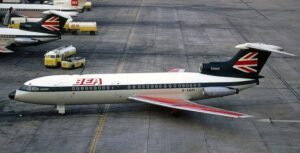
A British European Airways Trident
Image source: Chris England
What happens when a pilot faints during a flight?
Last Saturday, CNN Portugal reported that an EasyJet pilot fainted on an Airbus A320 flying from London Luton to Lisbon. In aviation terminology, fainting is classified under pilot incapacitation.
Pilot incapacitation may be obvious, such as during a complete loss of consciousness, or subtle, usually lasting less than 20 seconds. Subtle symptoms can be barely noticeable but can pose significant risks to aircraft operation.
The risk associated with pilot incapacitation depends on its onset. If a pilot faints during the cruise phase, it is generally not a major issue as the plane is typically on autopilot. The unaffected pilot would then declare an emergency, request assistance from a flight attendant to secure or remove the incapacitated pilot from his seat, and seek help from the company or any pilot passengers on board.
The most critical time for incapacitation is when the plane is close to the ground. For example, in 1972, a BEA flight from London Heathrow to Brussels crashed shortly after take-off. The captain’s subtle incapacitation, likely due to an abnormal heart condition, led him to retract the leading-edge devices at the wrong time, causing the crash.
Another critical scenario is incapacitation during auto-landing in poor weather. Standard challenge and response protocols have been established to manage such situations.
During flights, pilots assume the roles of Pilot Flying (PF) or Pilot Monitoring (PM). The PF flies the aircraft, while the PM monitors the PF’s actions, communicates with ATC, and changes the aircraft’s configuration under the PF’s command.
Both the captain and first officer can act as PF or PM, usually taking turns flying sectors. However, during a low-visibility approach, the PF is always the captain.
According to the ‘Challenge Rule,’ the PM calls a challenge above 1000 feet on the landing approach and waits for the standard response.
If below 1000 feet and the PF does not respond, the PM repeats the challenge. If there is still no response, the PM states the standard callout again.
Below 100 feet, if the captain remains unresponsive, the PM assumes the captain is incapacitated and takes control to land the plane or execute a go-around.
Pilot incapacitation is often practiced in flight simulators. As instructors, we frequently conduct this exercise by pre-briefing the PF to “die” at a predetermined phase of the landing. Upon a shoulder tap, the PF would “freeze and die.” We would then observe how the PM reacts to save the flight.
This exercise is crucial for training the monitoring pilot to remain vigilant during critical flight phases, especially during auto-landings in poor weather.
In the EasyJet case, since the pilot fainted outside the critical phases of flight, the captain landed the plane safely without much issue.
Read ‘Co-Pilot Faints in Lisbon-Bound Flight’
here https://www.ndtv.com/world-news/co-pilot-faints-on-lisbon-bound-flight-rare-red-alert-issued-6236842